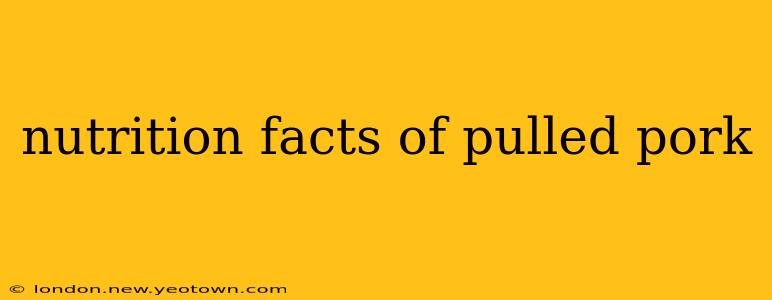Pulled pork, that succulent, slow-cooked delight, is a staple at backyard barbecues, festive gatherings, and even comforting weeknight dinners. But beyond its delicious taste and tender texture, what's the nutritional story behind this crowd-pleaser? Let's pull apart the facts and uncover the nutritional landscape of pulled pork.
The nutritional profile of pulled pork isn't one-size-fits-all. It significantly depends on several factors: the cut of pork used, the cooking method (smoked, baked, grilled), and—crucially—the additions you make. A simple pulled pork sandwich with a generous helping of BBQ sauce will have a vastly different nutritional makeup compared to a leaner version served with a side of steamed greens.
What are the nutritional benefits of pulled pork?
Pulled pork, when prepared thoughtfully, can offer several nutritional benefits. It's a good source of protein, essential for building and repairing tissues, and it contributes to satiety, keeping you feeling full and satisfied. Leaner cuts of pork, when appropriately trimmed of excess fat, provide a decent dose of protein with fewer calories and fat. Pork also contains certain vitamins and minerals, including thiamin (B1), niacin (B3), and vitamin B6, all crucial for energy metabolism and overall health.
How many calories are in pulled pork?
The calorie count in pulled pork varies considerably based on the factors mentioned earlier. A 3-ounce serving of lean pulled pork, without added sauces or fats, can hover around 150-200 calories. However, the addition of BBQ sauce, bread, coleslaw, and other accompaniments can quickly inflate the calorie count to well over 300 calories per serving, sometimes even exceeding 500. This significant increase is largely due to the added sugars, fats, and carbohydrates from these accompaniments.
Is pulled pork high in fat and cholesterol?
This is where the cut of pork and cooking method play a significant role. Fatty cuts, especially when prepared using methods that retain a lot of fat (like frying or slow-cooking with excessive amounts of rendered fat), will be higher in fat and cholesterol. However, leaner cuts of pork, like tenderloin or loin, prepared using healthier methods like baking or grilling, can significantly reduce the fat and cholesterol content. Choosing lean cuts and trimming visible fat before cooking is key to mitigating these concerns. Always remember that moderation is key; enjoying pulled pork as part of a balanced diet is a far healthier approach than overindulging.
How much protein is in pulled pork?
A 3-ounce serving of pulled pork can boast around 25-30 grams of protein. This makes it a solid choice for individuals who prioritize protein intake for muscle growth, repair, and satiety. However, it's important to remember that protein content will vary slightly depending on the cut and preparation method.
What are the downsides of eating pulled pork?
While pulled pork offers several nutritional advantages, potential downsides exist, primarily related to its fat and sodium content. Processed pulled pork, for example, often contains added sodium, preservatives, and sugars. These additions can negatively impact heart health and overall well-being. Excessive consumption of saturated fat can contribute to high cholesterol levels, increasing the risk of heart disease. Therefore, mindful preparation and portion control are crucial aspects of enjoying pulled pork as part of a healthy diet.
Is pulled pork healthy?
The healthfulness of pulled pork is a matter of context. When prepared using lean cuts, healthy cooking methods, and without excessive additions of high-fat and high-sugar sauces and condiments, pulled pork can fit comfortably within a balanced diet. However, relying on heavily processed, high-fat versions frequently can negatively impact your overall health. The key is moderation, mindful preparation, and a conscious selection of ingredients. Just like any other food, the moderation and balance of a healthy eating plan are crucial for maintaining overall health.

